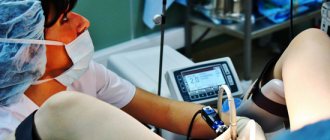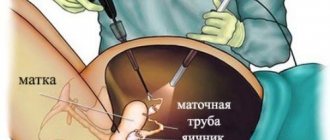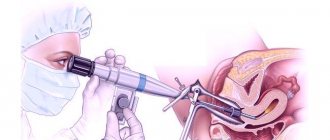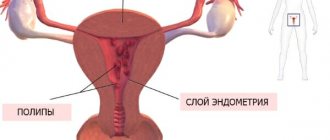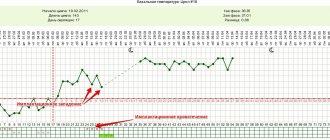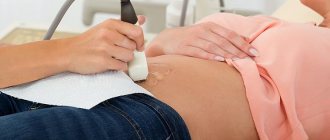Hysteroscopy is a procedure for examining the uterine cavity using a device that creates multiple magnification. There is a classic hysteroscopy - it is usually performed under anesthesia, requires large instrumental dilatation of the cervix and ends with curettage of the endometrium. And there is an “office” option - this is a mini-option, used only for diagnostic purposes, does not require pain relief, and is carried out in a antenatal clinic.
During office hysteroscopy, the endometrium is not removed, and therefore the procedure does not have any effect on the duration of the cycle. Even if in the process the doctor took a pinch - an endometrial biopsy. But the first option, with curettage, can disrupt the cycle and change the nature of menstruation.
Back to contents
How long does it take for the cycle to recover?
The main factor influencing the duration of normalization of the cycle is the type and nature of the effect during hysteroresectoscopy. If a diagnostic measure was carried out, the cycle after hysteroscopy should remain unchanged. In this case, menstrual bleeding proceeds according to schedule and does not change its color, consistency, duration or intensity.
Diagnosis is carried out in the following cases:
- identifying the causes of infertility;
- examination for hormonal contraception;
- study of the condition of the genital organs.
The procedure is also in demand if the patient suspects:
- endometrial hyperplasia;
- uterine fibroids;
- benign formations;
- intrauterine adhesions;
- abnormalities of the uterus;
- polyps;
- other pathologies.
If the violation is not confirmed and the doctor does not prescribe surgical intervention, then there will be no effect on the menstrual cycle.
As a result of the procedure, delays of up to two weeks are allowed. Bleeding is normal and not too painful or prolonged.
A similar situation also occurs during the following procedures:
- microhysteroscopy;
- control hysteroscopy.
After the procedure of separate diagnostic curettage, hysteroscopy with removal of tumors, dissection of adhesions, the woman recovers longer. In a normal situation, this period lasts 2-3 weeks.
The date of the operation should be considered the beginning of the cycle.
It is important to remember that after surgery, stabilization of the reproductive system may take several months. But menstrual bleeding after hysteroscopy should not be delayed longer than 14 days. Although there are exceptions.
When can hysteroscopy be prescribed?
This procedure is indicated for the following patient complaints:
- Bleeding in the middle of the cycle.
- Such menstrual irregularities as too heavy or scanty periods, their pain.
- Inability to become pregnant or bear a child.
The woman may not be bothered by anything or her complaints will be minor. But during a preventive examination and after taking smears, the doctor may suspect a pathology. Then laparoscopy will be needed for diagnosis and treatment:
- Congenital anomalies of the uterus - underdevelopment, uterine septum.
- Malignant tumors.
- Excessive growth of the muscle layer – adenomyosis.
- Myomas, polyps, erosions.
- Fallopian tube adhesions.
- With prolonged use of the intrauterine device, it can grow into the endometrium. It can be removed using hysteroscopy.
- To remove remnants of the fertilized egg or placenta after a failed pregnancy or childbirth.
- This procedure also evaluates the effectiveness of hormonal treatment.
The procedure is performed if a woman has had the IUD in place for a long time.
What influences the development of the female cycle
To answer the question of when will menstruation begin after hysteroscopy, it is necessary to take into account the presence of some factors:
- infection during the intervention or after the procedure;
- significant thinning of the uterine mucosa;
- the body’s reaction to manipulation in the form of severe stress;
- hormonal imbalance;
- complications during surgery.
Only a specialist can tell how quickly your period will begin in such situations.
First, you need to eliminate the harmful influence (cure infection, etc.), and then maintain your health. And also to determine the date of the first menstrual bleeding after surgery, the patient’s age and the general picture of the disease are taken into account.
Sometimes menstruation does not start due to pregnancy. Some women can conceive after just 14 days, so experts advise using contraception during the postoperative period.
Normalization of the cycle takes the longest time during curettage (curettage), especially against the background of a frozen pregnancy. The body suffers from a serious hormonal imbalance. The first menstruation will come in 2-3 months, and their irregularity and duration are allowed.
Features of menstrual cycle restoration after laparoscopy
Despite the fact that laparoscopy is a minimally invasive method in which, instead of an open operation, only three small punctures of the abdominal wall are performed, each body perceives it differently. And also surgical intervention on various organs of the female genital area can manifest itself in various variations.
One of the most important signs of normalization of the reproductive function of the female body is timely and normal periods. Based on the type and nature of menstruation after laparoscopy, it is easy for specialists to draw conclusions about the woman’s health condition and the need for further treatment.
Cyclicity must be stable
Why does discharge begin prematurely?
Menstrual flow that appears prematurely is not a pathology if the cycle shift does not exceed five days. An earlier onset of menstruation can be caused by emotional overstrain and stress in a woman. If you feel unable to cope, talk to your doctor about the possibility of prescribing sedatives.
Early menstruation also indicates the following problems:
- the occurrence of tissue inflammation;
- opening of bleeding.
Urgent diagnosis requires heavy, prolonged menstrual flow, which began much earlier than expected and is accompanied by pain in the lower back and abdomen.
What to do in case of deviations
After performing hysteroscopy, a competent gynecologist should tell the woman about the alarming symptoms that may appear during the first menstrual flow. The main reason for the development of complications is the woman’s violation of the prescribed regimen. The following symptoms should alert a woman:
- In due time there is no bleeding, there is pain in the lower abdomen. This may indicate the development of cervical spasm, when blood accumulates in the uterine cavity and is not able to flow out on its own;
- An increase in temperature against the background of acute pain in the abdominal area, the appearance of discharge with an unpleasant odor, and clots are signs of the development of infection after hysteroscopy. The infectious process develops when hygiene standards are not observed after surgery or the technique of performing the procedure is violated;
- Heavy discharge, when pads need to be changed up to 6 times a day and at night. They may indicate bleeding. This is a terminal condition that requires immediate hospitalization of the woman. The life and health of the patient depends on the timeliness of medical care;
- Black discharge mixed with pus against a background of severe pain in the lower abdomen and elevated temperature is a sign of endometriosis.
The development of these signs requires immediate consultation with a doctor, additional diagnostics, and treatment.
Delay after hysteroscopy
A long absence of menstruation after hysteroscopy with curettage is allowed only after the failed pregnancy has been eliminated. In other situations, it is difficult to determine exactly how long menstruation will be absent and when menstruation will begin after curettage. But monthly bleeding must begin no later than after five weeks.
A long delay is a serious cause for concern. A woman cannot independently determine the cause of the failure at home, and delay only aggravates the condition.
Menstruation may be delayed for the following reasons:
- cervical cramps;
- adhesions;
- severe inflammatory process;
- pathological tissue scarring;
- hormonal imbalances;
- non-compliance with the rules of the postoperative period.
Such violations cause a cycle failure in the form of a delay, worsen the woman’s well-being and negatively affect the state of the reproductive system. If the natural outflow of menstrual blood does not occur, then stagnation occurs. This accumulation of mucosal tissue provokes favorable conditions for dangerous bacteria and infections. There may also be a high body temperature and severe pain in the pelvic area.
Features of endometrial polyp
A polyp in the uterus is a benign formation that grows against the background of inflammatory processes in the genitourinary system. It is a glandular, fibrous or mixed growth that has a body and a leg. Its surface is formed from epithelial tissues, which on certain days of the menstrual cycle undergo the same changes as healthy tissues of the reproductive organ.
Benign neoplasms rarely transform into cancerous tumors, but nevertheless require treatment. The presence of affected areas leads to serious changes in the reproductive system. In this case, such clinical manifestations as bleeding after the end of the regulation, discomfort and pain during intimacy are noted.
If these symptoms appear, you should immediately seek help from a doctor. After conducting a full diagnosis and determining the extent of the lesion, the gynecologist will decide on the need to perform hysteroresectoscopy (a minimally invasive procedure to remove the tumor).
Scanty periods
Scanty periods after hysteroscopy should not bother a woman. A signal for concern and contacting a medical facility is less heavy menstruation, which has an unpleasant odor and also causes pain to the woman. The reason may be the formation of adhesions in the affected area, due to which the blood cannot fully come out on its own. And also the disorder is often caused by endometritis, which appears due to infection.
Among the non-dangerous causes of scanty discharge, it is worth highlighting:
- A small amount of blood due to stress or individual characteristics of the body.
- A woman’s predisposition to scanty discharge, which has manifested itself previously.
- Tissue sampling during the intervention, which could affect the intensity of menstrual bleeding.
- Removal during hysteroscopy of the cause of heavy female discharge (neoplasms, submucosal uterine fibroids).
- Taking hormones or oral contraceptives both before and after the procedure.
How to prevent complications
In order for the procedure and recovery period to be successful, it is recommended:
- Choose a specialist carefully - the technique of performing hysteroscopy and strict adherence to the rules of asepsis depend on him. A skilled doctor will even carry out surgical intervention in such a way as to minimize blood loss and not introduce infection into the uterine cavity.
It is not recommended to use tampons
- Refrain from sexual intercourse for 2-3 days after the diagnostic procedure, 1-2 weeks after surgery.
- Do not use tampons in the vagina or douching - this will help prevent complications after hysteroscopy.
- Do not visit the bathhouse, sauna, or take a bath. Warm showers are the safest choice.
- Do not lift heavy objects, avoid physical activity and hypothermia for 1-2 weeks.
- If the doctor prescribed antibiotics, hormonal or hemostatic drugs, do not ignore them. It is easier to play it safe than to treat the consequences later.
Hysteroscopy is an indispensable tool in modern medicine. It requires a responsible approach, but is the most gentle diagnostic tool in comparison with those previously used.
Heavy periods
The occurrence of heavy periods after hysteroscopy cannot be considered normal. To determine the violation, it is enough to conduct a test. If within an hour a woman’s usual pad becomes completely wet, then this blood loss is dangerous to health.
Additional symptoms:
- severe weakness;
- dizziness;
- decreased blood pressure;
- pallor of the skin.
It is very important to do everything possible to ensure that the woman gets to the hospital quickly. On the spot, the doctor will take measures to eliminate severe blood loss and stabilize the general condition.
Recommendations
In order for menstruation to quickly return to normal after hysteroscopy and the monthly cycle to be fully restored, it is necessary to strictly follow the doctor’s instructions.
Most recommendations are determined by the nature of the procedure, the type of pathology eliminated, the age of the patient and other factors.
Most often, this list includes the following tips:
- Refusal of sex. It is necessary to abstain from intimacy for at least 3-4 weeks. But many doctors insist on no sexual intercourse until the first period is complete. It is also worth using condoms in the future.
- Hygiene and bathing. You cannot take a bath, go to a sauna or bathhouse, or visit swimming pools, bets, lakes and other open bodies of water. For intimate hygiene, it is better to use special products with a neutral pH. Don’t forget to wash yourself twice a day and take a shower every day with a comfortable water temperature.
- Medicines. Any medications are taken only as prescribed by a doctor. In most cases, antibiotics and antimicrobial agents are prescribed to avoid inflammatory processes. It is also worth excluding aspirin, which provokes spotting and even bleeding.
- Additional tips. A woman needs to avoid physical activity, douching, tampons and other intravaginal products. It is also important to go to the toilet on time, little by little, and exclude heavy foods from your diet.
Bloody discharge after surgery
After curettage has been performed, slight bleeding similar to menstruation may appear. These are the remains of dead endometrium and particles of dried crust that formed on the functional layer of the reproductive organ as a result of the operation. Their release can be observed for up to ten days.
An alarming signal is prolonged bleeding, which gradually increases in volume. If they appear, you should immediately seek help from a doctor. Such symptoms often indicate the presence of concomitant pathology that was not identified during the diagnostic process.
Bleeding may end due to spasms in the cervical canal area. Such changes pose serious dangers. When fluid is retained in the cavity of the reproductive organ, there is a risk of the onset of an inflammatory process.
Hysteroscopy during menstruation
Whether it is possible to do hysteroscopy during menstruation is decided by the doctor. Menstruation is only a relative contraindication, so the procedure is not excluded in the presence of bloody discharge. But most often the specialist chooses the days after the end of menstruation, because blood makes the procedure less informative. The exception is for emergency events.
In all other cases, the doctor will rely on the condition of the patient and the endometrium. The ideal time is the middle of the cycle, when there is still a thin layer of mucous membrane with a minimum number of vessels. It is on days 7-9 of the cycle that the specialist is able to thoroughly examine the uterine cavity.
Therapeutic, control or hysteroscopy with RDV are modern, most informative methods of diagnosis, collection of materials for examination and elimination of various pathologies. In most cases, menstruation begins on time, may vary slightly, but soon returns to normal. It is necessary to seek medical help if your health deteriorates significantly, pain intensifies, bleeding begins, or there is a long delay.
When should your period come after the procedure?
The time of the next menstruation depends on the timing of hysteroscopy and its purpose, as indicated in the table.
| Day of the menstrual cycle during the procedure | Arrival day of next menstruation |
| On the 6th day of menstruation. This is the optimal date for hysteroscopy | After 28-30 days from the beginning of the previous menstruation, that is, the normal menstrual cycle |
| Any other day of the cycle after the discharge stops | 28-30 days after the procedure |
This is the average norm. Doctors consider cycle fluctuations within 3 months acceptable. Their features are shown in the table.
| Purpose of hysteroscopy | Arrival day of next menstruation |
| Diagnostic | According to the normal cycle, since the endometrium of the uterus is slightly damaged. |
| Operational | 28 – 30 days after the procedure. The uterus needs to recover after removal of tumors or curettage of the endometrium. |
The more serious the intervention, the longer it may take to restore the cycle.
Irregularities or absence of menstruation may last up to 2 months. In this case, it is better to undergo a preventive examination by a doctor.
